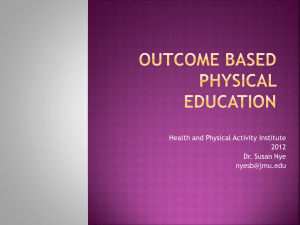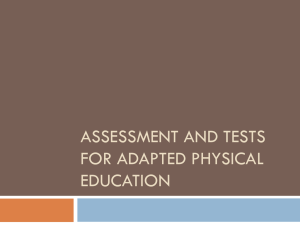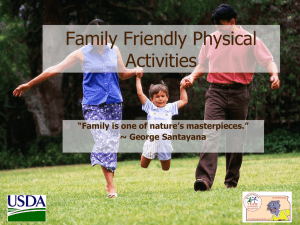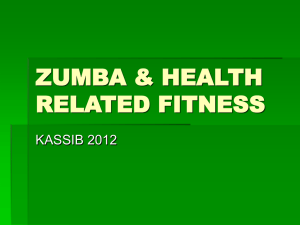Paul Clinton/Susan Sellers - TEPE
advertisement
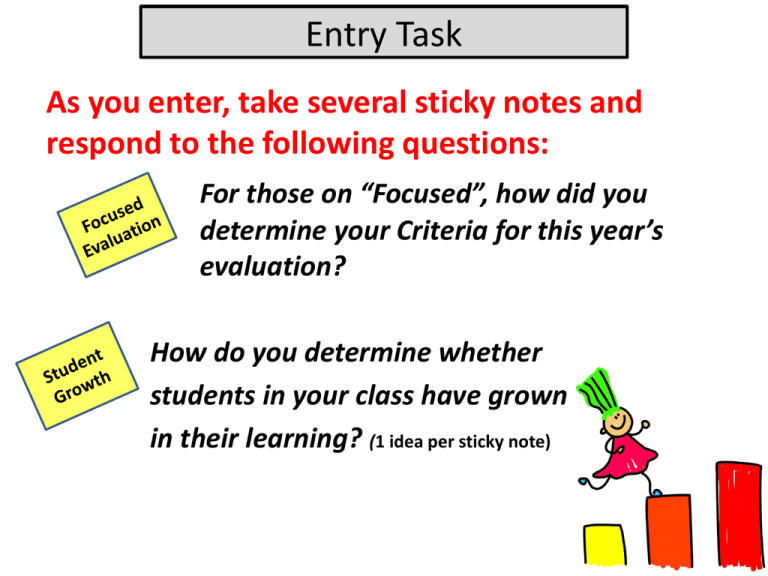
Entry Task As you enter, take several sticky notes and respond to the following questions: For those on “Focused”, how did you determine your Criteria for this year’s evaluation? How do you determine whether students in your class have grown in their learning? (1 idea per sticky note) TPEP: Writing Student Growth Goals & Strategies for a Successful Evaluation Susan Sellers, Paul Clinton October 18, 2014 SHAPE Washington\West’s Best Some materials for this presentation are courtesy of Scott Poirier from his Measures & Evidence Training spoirier@washingtonea.org developed for the WEA What are we going to Accomplish Strategies for a successful evaluation • Know the “State 8” • Know your Instructional Framework • Know yourself Writing Student Growth Goals • • • • • What’s important? The criteria The Goldilocks concept “Just Right” Nesting goals Examples Strategies for a Successful Evaluation: Centering instruction on high expectations of student achievement Demonstrating effective teaching practices Recognizing individual student learning needs and developing strategies to address those needs Providing clear and intentional focus on subject matter content and curriculum Know the “State 8” Fostering and managing a safe, positive learning environment Exhibiting collaborative and collegial practices focused on improving instructional practice and student learning Communicating and collaborating with parents and the school community Using multiple student data elements to modify instruction and improve student learning Strategies for a Successful Evaluation: Know your Instructional Framework CEL 5D+ Danielson Marzano Know Your Framework (Frameworks at a Glance: tpep-wa.org) CEL 5D+ Danielson Marzano Strategies for a Successful Evaluation: Know Yourself! Self Assessment Preparing for the Observations Providing Evidence Collecting Artifacts • Review the elements and critical attributes of each of the 8 Criteria • Identify points of focus – even if on “Comprehensive” • 2 observations of at least 15 min each for a total of at least 60 min. • Provide a detailed lesson plan that identifies the critical elements of your chosen Criteria. • Lesson Plans • Pictures and videos • Student Work Strategies for a Successful Evaluation: Resources • To learn more: edtech.wednet.edu/eVALTraining • To create and account: http:/eds.ospi.k12.wa.us • General teacher resources: tpep-wa.org • PE Specific Resources: shapewa.org Writing Student Growth Goals Write goals that reflect the major concepts you teach! • • • • Physical Skill Development. Health and fitness knowledge. Fitness Development. Applying health & fitness knowledge to students lives. • ? Writing Student Growth Goals Write goals that reflect what you do best or what is unique in your program. • • • • • Dance Outdoor education Game Strategy & Tactics Health & Fitness Portfolios ? How do we determine in physical education whether students in our class have grown in their learning? Student Growth • • • • • • • • • • • formative assessments Skill assessments rubrics Peer assessments Student Work Samples Student Portfolios Videos of performance Grades State CBA Written tests Unit assessments District Fitness Assessment Many want “Sameness” in measurements Measuring Student Growth Pyramid State-based Assessments District-Based Assessments School-Based Assessments Classroom-Based Assessments Tough Questions for Physical Educators • Can or should we use fitness testing data? • Does the evidence for student growth need to be the same for all students? What happens when non PE professionals define student goals for us? Physical Education Example: Students in a PE class are required to go through an obstacle course every two weeks during an 18 week PE class. Students strap on wrist heart rate monitors and record their heart rates every time they go through the obstacle course. At the end of 18 weeks, the PE teacher has a graph of every student in their class and can demonstrate that students are healthier at the end of 18 weeks than they were when they started the class by seeing students’ improved (lowered) heart rates on the graph. The teacher can take the graph off the wall and show the data to the principal. The teacher has demonstrated student growth between 2 (or more) points in time. 6.1 Goal: By the end of May, 4th grade students will all be in the Healthy Fitness Zone for their age and gender based on the Fitnessgram assessments: mile run, sit-ups and pushups. 6.2 Multiple Measures: Fitnessgram, student logs, charts of progress, teacher observation notes 3.1 Goal: By the end of May, students not in the Healthy Fitness Zone for their age and gender based on the fall Fitnessgram assessments: mile run, sit-ups and push-ups will progress to being in the Healthy Fitness Zone. 3.2 Multiple Measures: Fitnessgram, student logs, charts of progress, teacher observation notes 8.1 Goal: By the end of May, district 4th graders will all be in the Healthy Fitness Zone for their age and gender based on the Fitnessgram assessments: mile run, situps and push-ups. Team of district PE teachers will meet through PLC groups during available time to collaboratively discuss instructional strategies for improvement, examine student data and plan for instruction. Student Growth Rubric Language Criterion 3 SG 3.1 Establishes appropriate student growth goals for subgroups of students not reaching full learning potential. Goals identify multiple, high-quality sources of data to monitor, adjust, and evaluate achievement of goals. Criterion 6 SG 6.1 Establishes appropriate student growth goals for whole classroom. Goals identify multiple, high quality sources of data to monitor, adjust, and evaluate achievement of goals. SG 3.2 Multiple sources of growth or achievement data from at least two points in time show clear evidence of growth for most students. Criterion 8 SG 8.1 Consistently and actively collaborates with other grade-level, subject matter or instructional team members to establish goals, to develop and implement common, highquality measures, and to monitor growth and achievement during the year. SG 6.2 Multiple sources of growth or achievement data from at least two points in time show clear evidence of growth for most students. 17 SG 3.2 & SG 6.2 Unsatisfactory Basic Proficient Distinguished Growth or achievement data from at least two points in time shows no evidence of growth for most students. Multiple sources of growth or achievement data from at least two points in time show some evidence of growth for some students. Multiple sources of growth or achievement data from at least two points in time show clear evidence of growth for most students. Multiple sources of growth or achievement data from at least two points in time show evidence of high growth for all or nearly all students. SG 8.1 - Proficient Consistently and actively collaborates with other gradelevel, subject matter or instructional team members To establish goals To develop common high quality measures To implement common, high quality measures To monitor growth during the year To monitor achievement during the year. This is not about writing a goal. It’s about: • Your Personal contribution to be collectively responsible for student learning • One of the most powerful components to change a culture of collaboration • To collaboratively and actively participate in authentic practices that increase student achievement What is the difference in qualitative indicators in SG 8.1? Goldilocks Goals • Consider writing student growth goals with Goldilocks in mind: not too broad, not too narrow, but just right. 4 Parts of a Student Growth Goal Do something within a timeframe: Students will • demonstrate, create, analyze, compare, differentiate, compose, evaluate, design, synthesize, articulate, ect. Content: Specific to what students need to know Too Specific X Too Broad Evidence of learning/growth: How is success defined? Measures: formative & summative Example Goal STUDENT GROWTH GOAL Literacy: Informational Text Science - 6th Grade Too Narrow or Specific 6.1 All students will Whole make a Group prediction based on the title of a book. JUST RIGHT During first semester, my 4th period students will improve their ability to identify text-based evidence to evaluate predictions, inferences, and opinions. Students will improve at least one level in each of the three skills, as measured by a four-point rubric. Progress along the goal will be determined through a pre-assessment, graphic organizers, student work, formative assessments, and a postassessment. Too Broad or Large All of my students will understand and use text-based evidence to content areas. Example Goal for PE STUDENT GROWTH GOAL Physical Education - 6th Grade Too Narrow or Specific 6.1 All third period Whole students will Group improve their one minute sit-up score. Too Broad or Large During first semester, my 3th period All third period students will set a SMART goal to students will set improve on one of their fitness tests. SMART goals and Progress and growth will be evidenced reach the through student created graphs of their healthy level on progress and a written analysis of their all five district original SMART goal and results at the mandated end of the semester. fitness tests. JUST RIGHT Nesting the Goals Another way to think of the three student growth criteria is analogous to ‘nesting dolls,’ moving from large to small (SG 8.1 to SG 6.1 to SG 3.1) SG 8.1 SG 6.1 SG 3.1 Example of “Nested” Goals 8.1 Establish Team Student Growth Goals: During First Semester, 8th grade students will provide text-based evidence to support prediction, inference, and opinion as measured by a four-point rubric. Progress along the goal will be determined through a pre-assessment, graphic organizers, student work, formative assessments, and a summative postassessment. Success measured by SG 6.2 6.1 Classroom goals: During first semester, my 4th period students will improve their ability to provide text-based evidence to support prediction, inference, and opinion. Students will improve at least one level in each of the three skills, as measured by a four-point rubric. Progress along the goal will be determined through a pre-assessment, graphic organizers, student work, formative assessments, and a summative post-assessment. Success measured by SG 6.2 3.1 Subgroup goals: During first semester, a sub-group of students identified in the lowest tier of the rubric through a pre-assessment will improve their ability to provide text-based evidence to support prediction, inference, and opinion. They will use supports such as differentiated text, a scaffold frame, or an oral reader and uses texts appropriate to their reading level. Students will improve at least one level in two of the three skills, as measured by a four-point rubric. Success measured by SG 3.2 Example of Nested Physical Education Goals 8.1 Establish Team Student Growth Goals: The theatre department and physical education (teachers and students) will collaborate to introduce social dance to high school students. During a three week swing dance unit for three PE classes and the theatre class, students will progress from simple basic steps to complex swing dance combinations. Students will display the proper social skills needed when engaging in social dance with a partner of the opposite gender. Student led dance organizing committee will collaborate with the instructors to plan and implement the swing dance party for all four classes at the end of the unit. 6.1 Classroom goals: During a three week swing dance unit students will progress from simple basic steps to complex swing dance combinations. Students will display the proper social skills needed when engaging in social dance with a partner of the opposite gender. Swing dance physical skill acquisition will be evident in a pre-video taken in the first couple of days of the unit and a post-video of the culminating swing dance party that will be held with three classes. Social skill development will be evident on the dance party video and with a reflection piece that students will fill out at the end of the unit. Example of Physical Education Goals 3.1 Subgroup goals: During the course of the second semester, seniors in all classes will improve their personal fitness and relate these improvements to staying fit as adults. Seniors are the least fit of all the classes at our high school and this is at a time when they are about to enter the adult world of fitness that will be dependent completely on their own efforts and knowledge. Student performance will be measured in two ways. First by pre and post fitness testing for at least two of the twelve optional fitness tests as evidenced by student created graphs of their progress. Second, by SMART fitness goal setting in February and a written analysis of their efforts and results in June. Establishing Student Growth Goals 1. What are the major concepts you teach? 2. What do you do best or what is unique in your program? 3. What is your timeframe? 30 4. What do students need to know or demonstrate by the end of the timeframe? X Too Specific Too Broad 5. How will you define success/growth? 6. What formative & summative measures will you use?


